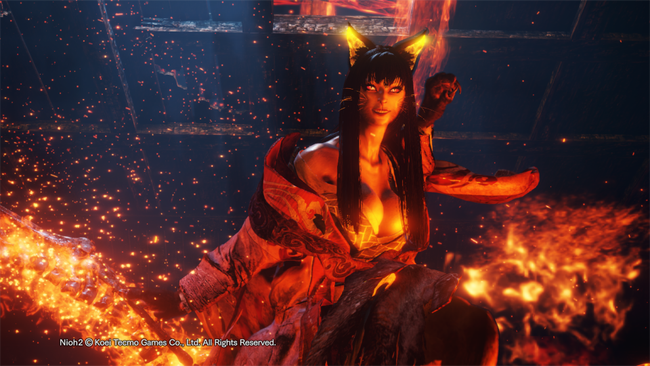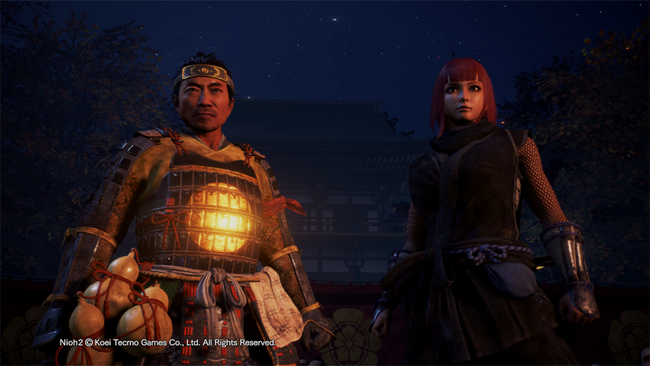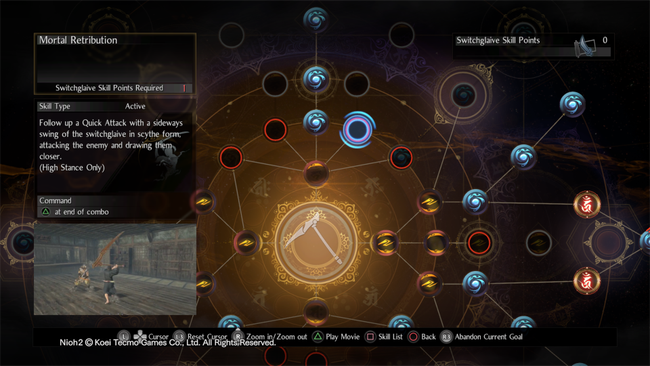
Nioh 2 Review
Back in 2017, Nioh had a lot to prove. At first sight, it just seemed like yet another game that was trying to imitate the popular Souls formula for some easy success. Those preconceptions were a bit misguided, though, as Nioh took elements of the Dark Souls series and added so much of its own personal flavor that comparing the two is wasn’t as easy as people initially thought it would be. Now we have Nioh 2, a sequel to that excellent game that comes in a very interesting and different context. How do you make a sequel to a game that no longer has to compete with Dark Souls?
I feel like the first thing to say about Nioh 2 is that it undoubtedly can be seen as more of the same. This franchise isn’t reinventing itself in the second entry, but rather building upon the systems and elements of the first that worked so well. That is not to say that Nioh 2 doesn’t do any new things, and in fact, it’s in these improvements where you can find the best aspects of the game. By taking the approach of “if it ain’t broken, don’t fix it” Nioh 2 is, indeed, better than the first one thanks to the quality of what’s new combined with the already excellent old elements.

The first major aspect of the game that has clearly been improved is the storyline. While there are certainly varying opinions on the plot elements of the first Nioh, to me, William’s story was quite bland. I felt like if you didn’t know enough about Japanese history, most of the motivations of the characters based on historical figures would just fly over your head. Nioh 2, which acts as a prequel, solves this problem in two ways: first of all, it lets you create your own character with an incredibly deep customization system; second, while the story still involves historical figures of Japan in the 1500 century, it is more of a personal story rather than that of a character whose primary goal is to participate in embellished historical military conflicts.
Your character is a Shiftling, who has half-human and half-yokai blood. Due to society’s judging eyes, your yokai mom had to abandon your human father and the two of you lived in seclusion. One day, a mysterious red-eyed man with a staff kills your mother, and she leaves you with a special dagger that can banish yokai. Your character then takes on the life of a mercenary hunting down any problematic yokai, but you ultimately lose control of yokai self during one of your hunts. A man named Tokichiro, with the power of the Spirit Stones (essentially the Amrita stones from the first game), calms you down and offers to work together with you. With your muscles and his brains, he intends to accomplish his dream of becoming someone important in life.
While the writing of the game is still nothing to write home about (in fact, your character is a silent protagonist), it’s the overall tone of the story that differentiates it a lot from the first Nioh. You and Tokichiro make quite the charming pair, and the story does a good job at depicting how the two of you continuously gain reputation. Very early on, you two even start working for none other than Oda Nobunaga himself, and he’s so pleased with you that you become his most trusted vassals in his campaign to unite Japan under his command. Of course, if you know Japanese history you already know how things go for Nobunaga, but unlike the first Nioh, it’s very easy to follow these conflicts because the focus is not on the conflicts themselves but rather on you and Tokichiro, and how this constant growth of reputation and use of Spirit Stones affects you as a pair.

The structure of the game and the way the story is told is pretty much the same as in the first Nioh. Unlike games like Dark Souls, Nioh has discrete missions, with maps that are linear in nature. However, this time around they feel bigger and with more places to explore. You will find shortcuts and such, but there are a lot more branching paths that end up converging and areas that are otherwise optional within a level, where you can usually find strong enemies guarding good loot or other useful items.
Just like in the previous game, loot plays a very important role in Nioh 2. This is the aspect of the game that most differentiates it from the Souls series, and it was the thing that kept me coming back to the first game until it stopped receiving new content. As it is, Nioh 2 is, unintentionally, releasing in a different context now. While the first game was inevitably compared to the Souls games at launch, that series is now over. From Software has more recently released Sekiro, a game somewhat similar in aesthetic to Nioh but completely different in terms of gameplay. I can perhaps see people comparing Nioh 2 to Sekiro, but the two games offer wildly different things.
Nioh 2 has all of the loot systems in place from the first game. Every piece of equipment has a rarity level. All of the different weapon types return and two new ones are added: the switchglaive and the hatchets. The blacksmith operates in the same way as it did before: it allows you to forge equipment; to feed one piece to another one in order to increase its level; to change the appearance of your weapons and armor; to disassemble an item in order to get forging materials; to reroll the individual skills of any piece of equipment. All of this contributes to the most important aspect that makes Nioh such a successful loot game. There is no ultimate weapon or build, but rather a degree of granular customization so deep that you can construct extremely powerful equipment tailored to the way you enjoy playing.

And playing Nioh is, frankly, a lot of fun. Anyone familiar with the fast-paced combat of the first game will feel right at home with Nioh 2. The Ki system is back, and it’s still key to the success of a fight: as you use your Ki (basically the stamina from Souls games), you can instantly recover a chunk of it by performing a Ki Pulse, which is essentially like the active reload mechanic some shooters have. Enemies also have Ki, and depleting theirs allows you to unleash a powerful grapple attack that most of the time is enough to finish them off. Yokai enemies can even be staggered after suffering enough Ki damage.
Since Ki is so important, it’s to be expected that the difficult parts of the game will try to mess with your Ki management, and that’s where one of the new mechanics comes in. Before, yokai could leave puddles called Yokai Realm that slowed down your Ki regeneration speed and needed to be purified with a Ki Pulse. Now, there are entire areas called Dark Realm, where that same effect applies and it even stacks with whatever Yokai Realm puddles the enemies might leave. Those areas are very tough, but they can be dispelled by killing one specific enemy, signified by a different aura. When the Dark Realm is banished, any remaining yokai alive will have their Ki depleted and some might even instantly die. It’s a very fun yet challenging mechanic since it even gives yokai enemies slightly different properties and sometimes even new combat abilities while in the Dark Realm.

Still, not all of this is bad for you, a half yokai. Nioh 2 replaces the Living Weapon system, in which you imbue your weapon with an element based on the Guardian Spirit of your choice, with the new Yokai Shift. Absorbing Amrita fills a gauge that, when full, allows you to transform into one of three different yokai forms, each specialized in different styles of combat. This adds even more variety since it is an entirely new moveset, rather than just the elemental damage from the first game. What’s more, you can collect Soul Cores dropped by yokai enemies to utilize specific skills based on their attacks. Every single yokai in the game, including bosses, can grant you new active skills that range from throwing a javelin that does massive Ki damage to transforming into one of the yokai enemies to lunge forward stabbing everything in your way.
Skill trees have also received noticeable improvements. Rather than the messy and sometimes confusing menu of the first game, Nioh 2 has skill trees presented like a sphere grid. Each weapon has its own tree and you gain more points by simply using that weapon. The same goes for the Ninjutsu and Onmyo Magic skills, which are still as useful as ever but not as borderline broken as they were in the previous game. You also have your general tree with abilities that apply regardless of your weapon of choice and even a Shiftling skill tree, that improves many of your yokai-related abilities and resistances.

If you’re having a hard time even with all of these mechanics that allow you to become the ultimate Shiftling, you can always rely on the online aspects of the game. As with the first game, you can summon players to help you out with a level, but this time around, there’s a new option for co-op that builds upon the Grave system from the previous game. In the first Nioh, graves that marked where a player died allowed you to summon a Revenant version of that player for you to fight and get some of their loot. Now, people can leave a blue-colored grave (that doesn’t involve dying) for others to summon their character as a helper. It is a neat twist that allows you to help other people without necessarily playing online with them since the character will be controlled by the AI.
This sequel also maintains the same technical qualities of the original. Just like before, you can opt to play the game in three different modes, prioritizing either resolution, framerate or a mix of both. Nioh 2 is even more beautiful than its predecessor, and there is a very real charm to seeing your own created character, with whatever gear you chose to give them, in all of the greatly directed cutscenes. The levels are also similar in style to those of the first game, although some of the later ones do quite unique things in terms of visual spectacle that make them a true joy to play.

At first glance, Nioh 2 might be more of the same, and on some level that is true. But what Nioh had to offer was an incredibly good, extremely enjoyable mix of elements that worked surprisingly well together. Nioh 2 simply embraces all its predecessor did well before, improves on some aspects that were there, and even allows you more freedom to enjoy the game however you want to play it. Those same elements that made the first one so enjoyable, combined with a better story, better customization systems, better level design and more, make Nioh 2 a confident sequel that stands above the previous game and firmly establishes itself as its own. No longer should Nioh be compared to other games; those other games should be compared to Nioh 2.